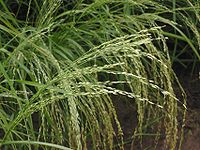
Photo from wikipedia
Teff (Eragrostis tef) is a major staple grain of Ethiopia, where the crop was domesticated from 4000 to 1000 BC. The high food‐value Teff flour is basically used for preparing… Click to show full abstract
Teff (Eragrostis tef) is a major staple grain of Ethiopia, where the crop was domesticated from 4000 to 1000 BC. The high food‐value Teff flour is basically used for preparing injera—a spongy pancake, the major component of the Ethiopian national dish. Due to its gluten‐free quality and high mineral content, the popularity of TeffTeff has been increasing in the western world. Very little is known, about the households that produce and consume Teff in Ethiopia. Using information from more than 9000 households collected by the World Bank and the Central Statistical Agency‐Ethiopia in 2011–2012 and 2013–2014, and applying econometric estimation approaches, this study reveals that Teff is mainly produced by uneducated, male‐headed rural households which have access to relatively more land and more family labor. In contrast, a higher proportion of Teff is consumed by urban households and those headed by an older, educated head. Based on the findings, this study asserts that the productivity of Teff should be enhanced by developing and disseminating high‐yielding varieties as Teff consumption has been increasing in general and, secondly, the resource‐poor Teff cultivators should be linked with the global value chain which may bring extra benefits to them in Ethiopia; however, the loss of domestic consumers’ surplus should also be considered economically. [EconLit citations : C24, C25, D12, D13, Q12, Q13].
Journal Title: Agribusiness
Year Published: 2018
Link to full text (if available)
Share on Social Media: Sign Up to like & get
recommendations!